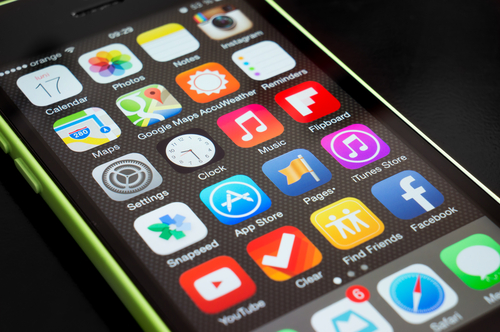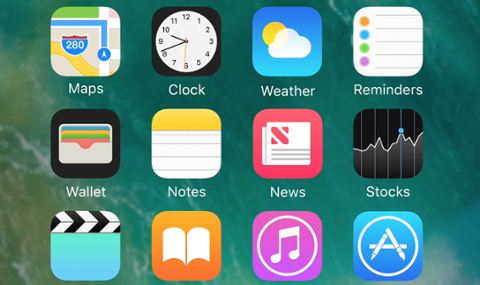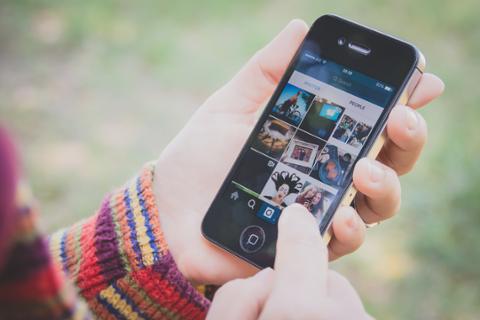[caption id="attachment_127167" align="aligncenter" width="500"]

App economy set to blossom in 2017[/caption] Now that we’re firmly in 2017, many developers are wondering what’s next for the app economy. App analytics firm App Annie might be able to help with that; the company has
penned some predictions for the new year, leveraging a look back at 2016 as inspiration. In the "Positives" column, App Annie believes that 2017 will bring “growth all around” during a "banner year," with spending across the App Store, Google Play and advertising to hit $166 billion. In-app advertising is expected to crest $100 million (mostly via social media, video and game apps), while the remaining revenue will come from direct app purchases and in-app spending. In a bold prediction, App Annie expects shopping apps will have a transformative effect on physical retail shops. During the first three quarters of 2016, time spent using shopping apps was up 52 percent year-over-year. (It’s unlikely that the fourth quarter, with so much holiday shopping, skewed that figure lower.) As App Annie writes: “In 2017, we expect the strongest growth to come from brick-and-mortar retailers as mobile apps reinvent the in-store experience.” Other physical businesses such as banks and quick-serve restaurants will “see an uptick in 2017 as companies learn to incorporate mobile into their operations.” Let’s hope this goes beyond ordering ahead at Chipotle and scanning receipts for rewards points. But the boost in stateside commerce could mean doom for some. App Annie points to Asia, where a big push for ride-sharing apps led to significant consolidation once venture capitalists were unable to reap rewards. It predicts IPOs are in store for some remaining commerce players during 2017. [caption id="attachment_138519" align="aligncenter" width="1360"]

Mac App Store WWDC 2016[/caption] Video will also reign supreme as the short-form format explodes. Those white-label videos (you know, series of images with text and music overlay) you see from some publications do really well on Facebook, and YouTube has seen a use-spike on Android as a result of shorter videos taking hold. Snapchat is also coming on strong in this area. But not all of 2016's darlings will take off. Chatbots will
still be useful for business-to-consumer use, App Annie believes, but won’t be much good beyond that : "Chatbots will still play a role, but artificial intelligence capabilities will not be sophisticated enough to carry on complete customer service conversations in 2017." Rather, chatbot use cases will "remain limited to notifications" and directing users to human customer-service reps. Finally, Augmented Reality (AR) is
set to make a splash in 2017. The game "Pokemon Go" proved a useful use-case for AR, and showed just how monetizeable it can be. Still, as App Annie points out, "Pokemon Go" was additive; 2017 could be the year AR becomes prescriptive, especially for companies with a physical footprint. Similarly, smartphone-based Virtual Reality (VR) will continue to outpace Oculus Rift and HTC’s Vive due to a “significantly lower ownership costs and a wider gamut of use cases, including 360-degree video for news, sports, entertainment and even education.” If you’re looking to give App Annie a bit of side-eye, it notes wearables will shift towards eyewear in 2017. While it points to Snapchat’s Spectacles as a good use case, the firm
seems to have forgotten Google Glass. App Annie doesn’t predict 2017 will necessarily prove a breakout year for connected eyewear, but companies may continue to invest in it.
 App economy set to blossom in 2017[/caption] Now that we’re firmly in 2017, many developers are wondering what’s next for the app economy. App analytics firm App Annie might be able to help with that; the company has penned some predictions for the new year, leveraging a look back at 2016 as inspiration. In the "Positives" column, App Annie believes that 2017 will bring “growth all around” during a "banner year," with spending across the App Store, Google Play and advertising to hit $166 billion. In-app advertising is expected to crest $100 million (mostly via social media, video and game apps), while the remaining revenue will come from direct app purchases and in-app spending. In a bold prediction, App Annie expects shopping apps will have a transformative effect on physical retail shops. During the first three quarters of 2016, time spent using shopping apps was up 52 percent year-over-year. (It’s unlikely that the fourth quarter, with so much holiday shopping, skewed that figure lower.) As App Annie writes: “In 2017, we expect the strongest growth to come from brick-and-mortar retailers as mobile apps reinvent the in-store experience.” Other physical businesses such as banks and quick-serve restaurants will “see an uptick in 2017 as companies learn to incorporate mobile into their operations.” Let’s hope this goes beyond ordering ahead at Chipotle and scanning receipts for rewards points. But the boost in stateside commerce could mean doom for some. App Annie points to Asia, where a big push for ride-sharing apps led to significant consolidation once venture capitalists were unable to reap rewards. It predicts IPOs are in store for some remaining commerce players during 2017. [caption id="attachment_138519" align="aligncenter" width="1360"]
App economy set to blossom in 2017[/caption] Now that we’re firmly in 2017, many developers are wondering what’s next for the app economy. App analytics firm App Annie might be able to help with that; the company has penned some predictions for the new year, leveraging a look back at 2016 as inspiration. In the "Positives" column, App Annie believes that 2017 will bring “growth all around” during a "banner year," with spending across the App Store, Google Play and advertising to hit $166 billion. In-app advertising is expected to crest $100 million (mostly via social media, video and game apps), while the remaining revenue will come from direct app purchases and in-app spending. In a bold prediction, App Annie expects shopping apps will have a transformative effect on physical retail shops. During the first three quarters of 2016, time spent using shopping apps was up 52 percent year-over-year. (It’s unlikely that the fourth quarter, with so much holiday shopping, skewed that figure lower.) As App Annie writes: “In 2017, we expect the strongest growth to come from brick-and-mortar retailers as mobile apps reinvent the in-store experience.” Other physical businesses such as banks and quick-serve restaurants will “see an uptick in 2017 as companies learn to incorporate mobile into their operations.” Let’s hope this goes beyond ordering ahead at Chipotle and scanning receipts for rewards points. But the boost in stateside commerce could mean doom for some. App Annie points to Asia, where a big push for ride-sharing apps led to significant consolidation once venture capitalists were unable to reap rewards. It predicts IPOs are in store for some remaining commerce players during 2017. [caption id="attachment_138519" align="aligncenter" width="1360"]  Mac App Store WWDC 2016[/caption] Video will also reign supreme as the short-form format explodes. Those white-label videos (you know, series of images with text and music overlay) you see from some publications do really well on Facebook, and YouTube has seen a use-spike on Android as a result of shorter videos taking hold. Snapchat is also coming on strong in this area. But not all of 2016's darlings will take off. Chatbots will still be useful for business-to-consumer use, App Annie believes, but won’t be much good beyond that : "Chatbots will still play a role, but artificial intelligence capabilities will not be sophisticated enough to carry on complete customer service conversations in 2017." Rather, chatbot use cases will "remain limited to notifications" and directing users to human customer-service reps. Finally, Augmented Reality (AR) is set to make a splash in 2017. The game "Pokemon Go" proved a useful use-case for AR, and showed just how monetizeable it can be. Still, as App Annie points out, "Pokemon Go" was additive; 2017 could be the year AR becomes prescriptive, especially for companies with a physical footprint. Similarly, smartphone-based Virtual Reality (VR) will continue to outpace Oculus Rift and HTC’s Vive due to a “significantly lower ownership costs and a wider gamut of use cases, including 360-degree video for news, sports, entertainment and even education.” If you’re looking to give App Annie a bit of side-eye, it notes wearables will shift towards eyewear in 2017. While it points to Snapchat’s Spectacles as a good use case, the firm seems to have forgotten Google Glass. App Annie doesn’t predict 2017 will necessarily prove a breakout year for connected eyewear, but companies may continue to invest in it.
Mac App Store WWDC 2016[/caption] Video will also reign supreme as the short-form format explodes. Those white-label videos (you know, series of images with text and music overlay) you see from some publications do really well on Facebook, and YouTube has seen a use-spike on Android as a result of shorter videos taking hold. Snapchat is also coming on strong in this area. But not all of 2016's darlings will take off. Chatbots will still be useful for business-to-consumer use, App Annie believes, but won’t be much good beyond that : "Chatbots will still play a role, but artificial intelligence capabilities will not be sophisticated enough to carry on complete customer service conversations in 2017." Rather, chatbot use cases will "remain limited to notifications" and directing users to human customer-service reps. Finally, Augmented Reality (AR) is set to make a splash in 2017. The game "Pokemon Go" proved a useful use-case for AR, and showed just how monetizeable it can be. Still, as App Annie points out, "Pokemon Go" was additive; 2017 could be the year AR becomes prescriptive, especially for companies with a physical footprint. Similarly, smartphone-based Virtual Reality (VR) will continue to outpace Oculus Rift and HTC’s Vive due to a “significantly lower ownership costs and a wider gamut of use cases, including 360-degree video for news, sports, entertainment and even education.” If you’re looking to give App Annie a bit of side-eye, it notes wearables will shift towards eyewear in 2017. While it points to Snapchat’s Spectacles as a good use case, the firm seems to have forgotten Google Glass. App Annie doesn’t predict 2017 will necessarily prove a breakout year for connected eyewear, but companies may continue to invest in it. 

